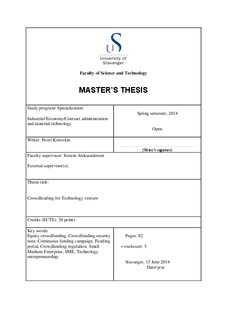| dc.contributor.author | Korovkin, Pavel | |
| dc.date.accessioned | 2014-10-08T11:49:41Z | |
| dc.date.available | 2014-10-08T11:49:41Z | |
| dc.date.issued | 2014-06-15 | |
| dc.identifier.uri | http://hdl.handle.net/11250/223398 | |
| dc.description | Master's thesis in Industrial economics | nb_NO |
| dc.description.abstract | Equity crowdfunding is a phenomenon that is emerging at this very moment. Although charity funding has existed for probably, centuries and reward based for years there is natural development and continuation aspiring now.
The next big step is equity crowdfunding open for broad public. So far, only certain qualified private investors and private entities were eligible.
The challenge is to open it for everyone. The process will truly take off when regulation authorities in the countries around the globe will adopt the laws and rules for that.
New rules apply to crowdfunding platforms from October 2014 in UK and in USA; they are in the final process of negotiation.
There are many opportunities and pitfalls. First, the current equity crowdfunding experience studied to draw some conclusions for future development. Few examples from already funded projects used to illustrate the points.
This work focuses on the key areas of public available crowdfunding also called crowd investing. Probable solutions discussed and criticism from experienced private investors addressed.
Different countries are trying to overcome the fact that their securities regulations and laws adopted long before the term crowdfunding came into life. Few countries exemptions from current regulations studied and compared.
Based on the information collected a model for equity crowdfunding process is discussed. Discussion includes proposal to special equity crowdfunding security note and what properties it should have. Some thoughts on further process regulation like continuous funding campaign, internal and external audits by venture backers are described. A potential evolutionary way of funding through funds and further development of crowdfunding platforms is proposed.
The whole crowdfunding process is looked at solely through perspective of a technological startup venture searching for the funding and other cases are omitted.
The most attention is paid to equity in form of securities funding. Lending, as being mostly, a straightforward process, is touched briefly and mostly overlooked.
Further research section lists opportunities for investigation as the whole process rolls out over time. | nb_NO |
| dc.language.iso | eng | nb_NO |
| dc.publisher | University of Stavanger, Norway | nb_NO |
| dc.relation.ispartofseries | Masteroppgave/UIS-TN-IØRP/2014; | |
| dc.rights | Attribution-ShareAlike 3.0 Norway | * |
| dc.rights.uri | http://creativecommons.org/licenses/by-sa/3.0/no/ | * |
| dc.subject | industriell økonomi | nb_NO |
| dc.subject | contract administration | nb_NO |
| dc.subject | crowdfunding | nb_NO |
| dc.title | Crowdfunding for Technology venture | nb_NO |
| dc.type | Master thesis | nb_NO |
| dc.subject.nsi | VDP::Social science: 200::Economics: 210 | nb_NO |

